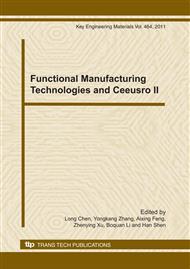p.478
p.482
p.487
p.492
p.496
p.501
p.506
p.510
p.514
Research on the Surface Roughness of Dry Cutting Different Levels of Austempering Ductile Iron (ADI)
Abstract:
Three cutting tools of different materials (ceramics CC6050, cubic boron nitride CB7025, carbide GC2025) are used for dry turning of 9 groups of ADI which heat-treated under different quenching time and quenching temperature. The surface roughness of ADI workpieces were tested after the finish turning at changed cutting parameters, and the influencing factors of surface quality were analysed. Results showed that the surface roughness values of all 9 groups of ADI workpieces obtained by CC6050 were the lowest and the surface quality was better at lower depth of cut ap and feed rate f with higher cutting speed vc . Meanwhile, the surface roughness was influenced by the isothermal quenching parameters of ADI workpieces significantly.
Info:
Periodical:
Pages:
496-500
Citation:
Online since:
January 2011
Authors:
Price:
Сopyright:
© 2011 Trans Tech Publications Ltd. All Rights Reserved
Share:
Citation:


